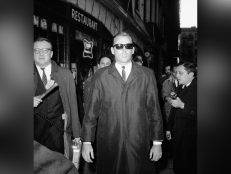The Controversial Execution of Teresa Lewis, Who Had Her Husband & Stepson Killed for Cash

Virginia Department of Corrections
At 9 P.M. on September 23, 2010, Teresa Lewis was executed for the 2002 shotgun killings of her husband and stepson, who were murdered while they slept at their mobile home in rural Pittsylvania County.
It was the first time that the state of Virginia had executed a woman since 1912.
Prosecutors said that Teresa, a 41-year-old grandmother, wanted the $250,000 life insurance policy that her stepson had taken out as a U.S. Army reservist in anticipation of his deployment to Iraq.
The gunmen, Rodney Fuller and Matthew Shallenberger, were strangers she met at Walmart. Teresa began a sexual relationship with the pair, and promised them a cut of the insurance payout so that they would agree to shoot her husband Julian Clifton Lewis, 51, and his 25-year-old son, Charles “C.J.” Lewis on October 30, 2002. Both men were later sentenced to life in prison.
But Teresa’s lawyers claimed that she was borderline mentally disabled, numbed by drug addiction, and impaired by a personality disorder that made her particularly dependent on men. So was she an evil mastermind — or the victim of a string of manipulative men?
Teresa grew up poor in Danville, Virginia, and dropped out of school at age 16 to marry a man she met in church. The couple had one daughter, Christie, but when the marriage ended in divorce, Teresa became dependent on drugs and alcohol. She skipped from job to job, and had held nearly 50 low-wage positions by the time she arrived at the Dan River, Inc., textile factory in 2000. It was there that she met and married her boss, Julian Clifton Lewis, an older man, and a widower.
Teresa learned about the insurance policy that C.J. has taken out, and that his father was listed as the beneficiary — but if something happened to Julian, the money would go to Teresa.
It was the fall of 2002, when Teresa met Shallenberger and Fuller, who were roommates in a nearby mobile home. In late October, knowing that C.J. was due for a visit home from training with his unit in Maryland, Teresa took $1,200 out from the bank to buy shotguns and ammunition.
On the night of the murders, she left the back door unlocked and waited in the kitchen while Shallenberger shot Julian and Fuller went to Charles’ bedroom and killed him with three shotgun blasts.
As Julian lay dying, his wife returned to the bedroom — and stole $300 from his wallet, which she gave to the gunmen.
Shockingly, Julian didn’t die immediately and lay in a pool of blood, moaning. Still, Teresa waited over an hour before dialing 911, claiming that unknown men had broken in and shot her husband and stepson. Still living when the authorities arrived, Julian managed to say “My wife knows who done this to me,” to a sheriff’s deputy. He died a short time later from loss of blood.
To learn more about this case, watch the “Second Chance At Death” episode of Investigation Discovery’s Fatal Vows on ID GO now!
After first insisting that her husband and stepson were the victims of unknown intruders, Teresa Lewis eventually confessed her involvement to police. She was convicted and sentenced to death in 2002.
But after the verdict, new evidence about Teresa and the gunmen emerged that raised questions about whether she was fairly sentenced. Some felt that it was unfair that the men who actually committed the murders were allowed to live, while Teresa, who didn’t pull the triggers, was executed. But Judge Charles Strauss reasoned that Teresa was “clearly the head of this serpent.”
Teresa took two IQ tests after the trial, one by her own expert and one by the state’s expert, and she scored 73 and 70 on them, which placed her in the “borderline intellectual functioning” zone.
Three different forensic psychology experts also testified that Lewis had “dependent personality disorder,” which they said would making it very difficult to function doing even the simplest tasks without the support of another person.
In addition, Shallenberger wrote a letter to a fellow inmate in 2003 in which he revealed that he had manipulated Lewis into going along with his plan.
“I met Teresa at the Walmart in Danville, VA. From the moment I met her I knew she was someone who could be easily manipulated,” Shallenberger wrote. “Killing Julian and Charles Lewis was entirely my idea. I needed money, and Teresa was an easy target.”
But after Shallenberger committed suicide in prison, Lewis’ defense team was not able to use the letter as evidence.
Teresa never claimed to be innocent, and according to authorities, she was a model Death Row inmate.
“The night of my crime I had Jesus telling me not to let this happen, and the Devil telling me to do it! Well, stupid me chose Satan’s way,” Lewis wrote in a statement to her fellow inmates that was read at a religious service at Fluvanna Correctional Center. Her last meal was fried chicken and peas.
Watch Now:
Read more: Roanoke.com, WHSV, Inquisitr.com, HuffingtonPost.com, StyleWeekly.com

![Selena receives a Grammy Award at The 36th Annual Grammy Awards in March 1994 [via Getty Images]](http://investigationdiscovery.sndimg.com/content/dam/images/investigationdiscovery/crimefeed/legacy/2021/03/getty-selena-quintanilla-perez-1309300538.png.rend.hgtvcom.231.174.suffix/1617128091576.png)







![David Dwayne Anderson (left) and Sylvia Quayle (right) [via the Cherry Hills Village, Colorado Police Department]](http://investigationdiscovery.sndimg.com/content/dam/images/investigationdiscovery/crimefeed/legacy/2021/04/sylvia-quayle-david-dwayne-anderson-040921.png.rend.hgtvcom.231.174.suffix/1617997281780.png)